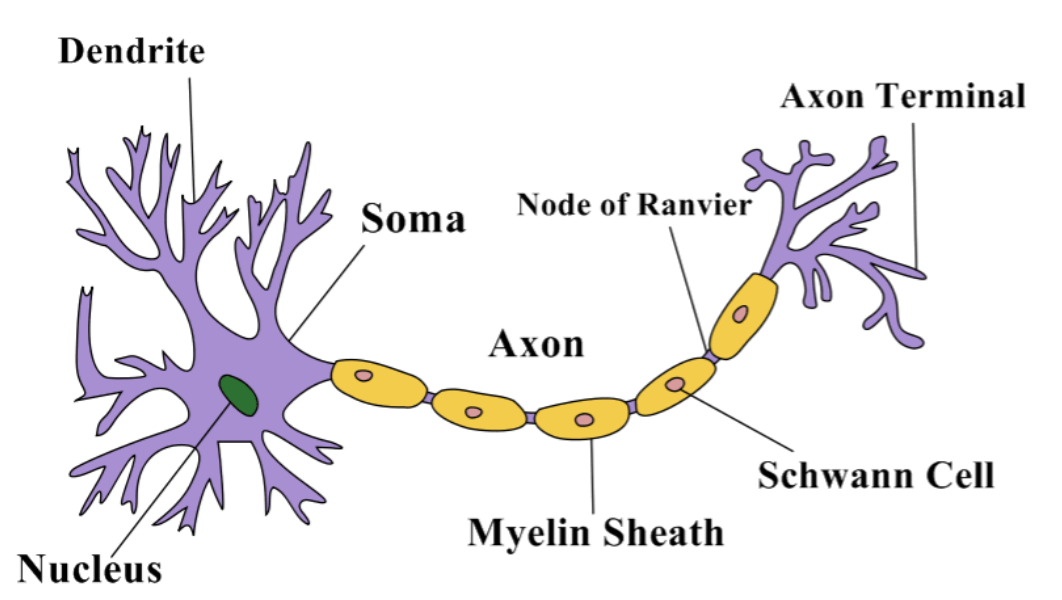
Draw a labelled diagram of the neuron and describe the structure of the neuron in detail.
Answer
568.2k+ views
Hint: The cell forms the basic unit of life. Every part of the body has a specialized cell which will perform only a particular activity. They work in the specified area. They are composed of various units which will enhance their efficiency.
Complete answer:
Brain is the most important organ of the body as it coordinates the whole body to work together. The cells of the brain are called the nerve cells/neuron.
They form the structural unit as well as the functional unit of the nervous system. They have major 3 components- Cell body, Axon and dendrites.

1. Cell body: It forms the cytoplasm of the nerve cell. It is polyhedral in shape. It also has the granular bodies known as Nissl's granules. Their major function is to synthesize protein via the ribosomes.
2. Dendrites: This is the branched fibril part of the neuron. They transmit the electrical impulse towards the cyton or cell body. They protrude out of the cell body.
3. Axon: These form the distal part of the neuron. They are the long fibres protruding from the cell body. It ends in the synaptic knob. Neurotransmitters are filled in this area of neurons. Axon has Axoplasm, myelin sheath, neurilemma and nodes of Ranvier.
Hence, the correct answer is option (B).
Note: The average brain has millions of neurons. The diameter of the neuron can be up to 100 microns. They are the electrically excited cells of the body. They form the component of the brain, spinal cord and peripheral nerves. They all make the nervous system.
Complete answer:
Brain is the most important organ of the body as it coordinates the whole body to work together. The cells of the brain are called the nerve cells/neuron.
They form the structural unit as well as the functional unit of the nervous system. They have major 3 components- Cell body, Axon and dendrites.

1. Cell body: It forms the cytoplasm of the nerve cell. It is polyhedral in shape. It also has the granular bodies known as Nissl's granules. Their major function is to synthesize protein via the ribosomes.
2. Dendrites: This is the branched fibril part of the neuron. They transmit the electrical impulse towards the cyton or cell body. They protrude out of the cell body.
3. Axon: These form the distal part of the neuron. They are the long fibres protruding from the cell body. It ends in the synaptic knob. Neurotransmitters are filled in this area of neurons. Axon has Axoplasm, myelin sheath, neurilemma and nodes of Ranvier.
Hence, the correct answer is option (B).
Note: The average brain has millions of neurons. The diameter of the neuron can be up to 100 microns. They are the electrically excited cells of the body. They form the component of the brain, spinal cord and peripheral nerves. They all make the nervous system.
Recently Updated Pages
Master Class 11 Social Science: Engaging Questions & Answers for Success

Master Class 11 Physics: Engaging Questions & Answers for Success

Master Class 11 Maths: Engaging Questions & Answers for Success

Master Class 11 Economics: Engaging Questions & Answers for Success

Master Class 11 Computer Science: Engaging Questions & Answers for Success

Master Class 11 Chemistry: Engaging Questions & Answers for Success

Trending doubts
What is meant by exothermic and endothermic reactions class 11 chemistry CBSE

10 examples of friction in our daily life

One Metric ton is equal to kg A 10000 B 1000 C 100 class 11 physics CBSE

1 Quintal is equal to a 110 kg b 10 kg c 100kg d 1000 class 11 physics CBSE

Difference Between Prokaryotic Cells and Eukaryotic Cells

The camels hump is made of which tissues a Skeletal class 11 biology CBSE




